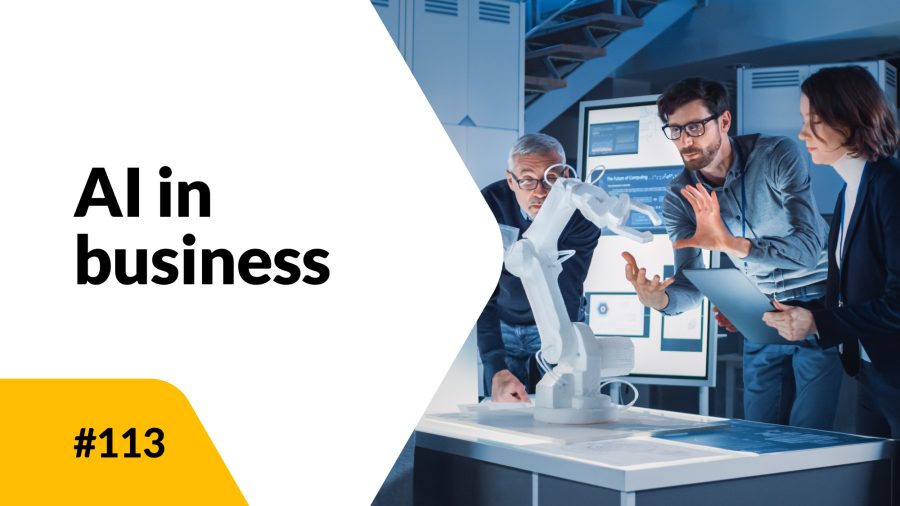Small and medium-sized companies are quickly and effectively implementing the latest advances in artificial intelligence. AI in SMEs is advanced artificial intelligence that was once only available to industry giants. Now it opens up huge opportunities for smaller players to compete effectively. Let’s take a look at how AI can help SMEs thrive and even compete with the largest companies through flexibility and agility. Read on to find out more.
AI in SMEs – table of contents
Benefits of AI in SMEs
To discover the potential of artificial intelligence for small and midsize businesses, we must first understand the areas where it can be most effective. AI is no longer a technology for the giants. Although its use is not yet widespread – according to a recent KPMG survey, 15% of small and medium-sized companies in Poland have implemented AI solutions in the past year, and another 13% are planning to do so.(https://kpmg.com/pl/pl/home/media/press-releases/2023/07/media-press-sztuczna-inteligencja-w-firmach-w-polsce-potencjal-do-wykorzystania.html).
This growing enthusiasm is certainly no accident. With the help of AI, smaller businesses have access to tools that allow them to increase efficiency while reducing operating costs. For SMEs, this means the ability to scale operations, use resources more efficiently, and ultimately compete with larger rivals on better terms.
However, the potential of AI in SMEs goes beyond savings. Flexible AI systems can skillfully forecast trends by analyzing vast amounts of data, facilitating the process of making strategic business decisions.
Business processes prone to optimization
AI support offers SMEs a huge space to optimize key operations. Let’s take a look at selected areas where the implementation of artificial intelligence is yielding tangible results:
- automating repetitive tasks – AI systems are successfully performing tasks such as data entry, sending invoices, or scheduling social media posts. They handle monotony more efficiently than humans, allowing employees to focus on more complex and creative challenges,
- generating content and strengthening the brand – regularly publishing new, engaging content supports site positioning and builds brand awareness. However, this is often a challenge for small marketing departments. AI makes it easy to create unique content – from social media posts to graphics and videos,
- customer relationship management – pervasive personalization plays an increasingly important role in building customer loyalty. AI allows you to track customers’ interactions with your brand in detail (e.g., analyze time spent on the site, frequency of visits, or purchase history). Based on this data, you can recommend relevant products and services to strengthen relationships,
- data analysis and automated inference – machines are far superior to humans when it comes to processing massive amounts of data. Thanks to self-learning algorithms, AI can detect even small, subtle patterns and trends that are beyond human analytical capabilities. Used properly, this data becomes a source of important insights to support business development.
AI tools and platforms for SMEs
The emergence of groundbreaking systems like ChatGPT (https://chat.openai.com/) and Google Gemini (https://gemini.google.com/) is already revolutionizing the way SMEs approach the use of AI. Based on advanced machine learning algorithms, they can analyze almost any information available on the Internet and provide insightful, tailored answers.
Although they are general-purpose tools, thanks to the ability to ask AI questions (prompting), you can get insightful conclusions from them based on well-chosen sources. The option to attach your own documents, on the other hand, makes chatbots experts available at your fingertips.
The range of AI tools for SMEs continues to grow. Jasper (https://www.jasper.ai/) or Canva (https://www.canva.com) enable the creation of first-class text and graphic materials, while Synthesia (https://www.synthesia.io/) and Runway (https://runwayml.com/) focus on video production. Open source language models that can be modified for specific business needs and even installed on your own computer are also an interesting alternative.
There are now more than 13,000 tools that use AI, and it’s worth starting with There’s An AI for That (https://theresanaiforthat.com/) or the slightly smaller Futuropedia (https://futurepedia.io/). With a clear categorization of tools and a search engine, it’s easy to find a solution that fits your organization’s needs.
It’s worth remembering that in addition to tools, you can also look into specialized training. After all, according to a study conducted on Boston Consulting Group employees, well applied artificial intelligence can improve employee productivity by 40%. However, used poorly – it will reduce it by 18% (https://papers.ssrn.com/sol3/papers.cfm?abstract_id=4573321).
AI strategy
Implementing AI is a process that requires careful planning and consistent execution. In order to successfully compete with larger companies and implement AI in SMEs exactly where it can bring the most benefit, it will be necessary to:
- conduct an audit of the business processes and business areas that are prone to optimization,
- define objectives and expected benefits (e.g., increased productivity, reduced costs, increased sales),
- estimate the investment, resources, and training required.
It is worth starting by launching pilot projects to test various AI solutions. This will allow you to quickly verify your assumptions and make it easier to change direction if implementation does not yield the expected results.
To make implementation easier, consider working with experts who can help you develop a strategy tailored to your organization’s specific needs. The key to success will be regular reviews, evaluation of results and optimization of the implemented systems. In other words, a strategic approach and transparency of operations that make it easier for the company’s team to understand the changes and be involved in every step of the transformation process.

Source: Midjourney, prompt: Marta M. Kania (https://www.linkedin.com/in/martamatyldakania/)
Changing the operating paradigm with AI
The implementation of AI in SMEs involves a fundamental change in the business model. These changes often affect almost every aspect of the business – from day-to-day operations, to customer interactions and strategic operations. Here are examples of areas where strong paradigm shifts are already evident:
- document processing – through natural language processing, AI can help automate a company’s workflow, from invoices to correspondence and logistics documents,
- generating content and enhancing brand image – AI tools like ChatGPT are becoming de facto collaborators with creative departments. They make it possible to instantly create unique content-professional copy, compelling graphics, and even dynamic, trendy video ads. All of this strengthens your brand and generates leads,
- business analytics – advanced algorithms process gigantic amounts of data and catch even subtle patterns that might be missed by humans.This deep analysis of the market and customers allows for more accurate strategic decisions based on data, not intuition,
- sustainable development – AI has also revolutionized the way we look at sustainability issues. Intelligent systems help track energy consumption, analyze the carbon footprint of operations, and identify areas for optimization. What’s more, they can predict and prevent waste by modeling future scenarios.
Security in the era of AI
As the importance of AI in business grows, so does the need to ensure the security of the data collected and how it is processed. Equally important are the ethical issues associated with the use of artificial intelligence, the implementation of Explainable AI, and transparent data processing practices. Supporting AI therefore brings both opportunities and risks:
- Cybersecurity. AI can identify potential vulnerabilities in systems and predict attempted cyberattacks. For example, technology developed by Mastercard catches potentially fraudulent transactions in as little as 50 milliseconds, three times more efficiently than older systems.(https://www.mastercard.com/news/press/2023/july/mastercard-leverages-its-ai-capabilities-to-fight-real-time-payment-scams/). This gives SMEs access to advanced security features previously available only to giants.
- Data privacy. At the same time, the integration of AI systems requires the highest standards of data protection, especially for sensitive customer or employee data. Algorithms, even the best ones, can carry the risk of making erroneous conclusions that result in decisions violating individual privacy. Therefore, AI solutions should be implemented cautiously, after analyzing the potential impact.
- Transparency. When implementing AI, accountability of systems and transparency of data processing should be considered from the outset. This is especially important when processing personal data, both of customers, employees, and candidates applying for jobs with the company.
Continuous training and development
Successful implementation of AI requires overcoming several barriers on the part of SMEs. The first is the need for additional training for employees, who must learn how to use the tools and often take on new responsibilities. The second is the allocation of an adequate budget for the transformation process.
Overcoming both of these obstacles requires determination and a conscious effort to improve skills at many levels. It is necessary not only to train executives and operational teams, but also to develop the skills of analytical or digital product managers. It is worth considering working with experts who can help you understand the specifics of each AI solution and select the right tools.
AI-driven digital transformation is an evolutionary process. Regularly updating deployed systems and retraining employees ensures that SMBs stay on the wave of innovation and not only keep up with, but stay ahead of the competition.

Source: Midjourney, prompt: Marta M. Kania (https://www.linkedin.com/in/martamatyldakania/)
Summary. Competitive advantage through AI in SMEs
So can AI help SMEs compete with the giants? Definitely yes. Changing the structure of a company, acquiring new skills, or implementing innovative tools to increase competitiveness is much easier in an SME.
SMEs can definitely benefit from the potential of AI and see it as an opportunity for a real competitive advantage over large corporations.
Optimizing processes, personalizing through customer data analytics, better tailoring product and service offerings, and thus increased sales and customer loyalty – this is just the beginning of the positive impact of AI in SMEs.
With improved tools (such as PowerBI and Tableau), SMEs also gain access to market analysis and insights at the level of large corporations. Meanwhile, advanced AI algorithms provide the ability to predict consumer trends and plan company growth strategies more accurately.
Competitive advantage through AI support stems from a whole new scale and level of automation, analysis, and optimization of business processes. It also results from strengthening the capabilities of the company’s employees, who can perform their tasks faster and more accurately. Investing in these areas today can determine the future success of even the smallest business.

If you like our content, join our busy bees community on Facebook, Twitter, LinkedIn, Instagram, YouTube, Pinterest, TikTok.
Author: Robert Whitney
JavaScript expert and instructor who coaches IT departments. His main goal is to up-level team productivity by teaching others how to effectively cooperate while coding.
AI in business:
- Threats and opportunities of AI in business (part 1)
- Threats and opportunities of AI in business (part 2)
- AI applications in business - overview
- AI-assisted text chatbots
- Business NLP today and tomorrow
- The role of AI in business decision-making
- Scheduling social media posts. How can AI help?
- Automated social media posts
- New services and products operating with AI
- What are the weaknesses of my business idea? A brainstorming session with ChatGPT
- Using ChatGPT in business
- Synthetic actors. Top 3 AI video generators
- 3 useful AI graphic design tools. Generative AI in business
- 3 awesome AI writers you must try out today
- Exploring the power of AI in music creation
- Navigating new business opportunities with ChatGPT-4
- AI tools for the manager
- 6 awesome ChatGTP plugins that will make your life easier
- 3 grafików AI. Generatywna sztuczna inteligencja dla biznesu
- What is the future of AI according to McKinsey Global Institute?
- Artificial intelligence in business - Introduction
- What is NLP, or natural language processing in business
- Automatic document processing
- Google Translate vs DeepL. 5 applications of machine translation for business
- The operation and business applications of voicebots
- Virtual assistant technology, or how to talk to AI?
- What is Business Intelligence?
- Will artificial intelligence replace business analysts?
- How can artificial intelligence help with BPM?
- AI and social media – what do they say about us?
- Artificial intelligence in content management
- Creative AI of today and tomorrow
- Multimodal AI and its applications in business
- New interactions. How is AI changing the way we operate devices?
- RPA and APIs in a digital company
- The future job market and upcoming professions
- AI in EdTech. 3 examples of companies that used the potential of artificial intelligence
- Artificial intelligence and the environment. 3 AI solutions to help you build a sustainable business
- AI content detectors. Are they worth it?
- ChatGPT vs Bard vs Bing. Which AI chatbot is leading the race?
- Is chatbot AI a competitor to Google search?
- Effective ChatGPT Prompts for HR and Recruitment
- Prompt engineering. What does a prompt engineer do?
- AI Mockup generator. Top 4 tools
- AI and what else? Top technology trends for business in 2024
- AI and business ethics. Why you should invest in ethical solutions
- Meta AI. What should you know about Facebook and Instagram's AI-supported features?
- AI regulation. What do you need to know as an entrepreneur?
- 5 new uses of AI in business
- AI products and projects - how are they different from others?
- AI-assisted process automation. Where to start?
- How do you match an AI solution to a business problem?
- AI as an expert on your team
- AI team vs. division of roles
- How to choose a career field in AI?
- Is it always worth it to add artificial intelligence to the product development process?
- AI in HR: How recruitment automation affects HR and team development
- 6 most interesting AI tools in 2023
- 6 biggest business mishaps caused by AI
- What is the company's AI maturity analysis?
- AI for B2B personalization
- ChatGPT use cases. 18 examples of how to improve your business with ChatGPT in 2024
- Microlearning. A quick way to get new skills
- The most interesting AI implementations in companies in 2024
- What do artificial intelligence specialists do?
- What challenges does the AI project bring?
- Top 8 AI tools for business in 2024
- AI in CRM. What does AI change in CRM tools?
- The UE AI Act. How does Europe regulate the use of artificial intelligence
- Sora. How will realistic videos from OpenAI change business?
- Top 7 AI website builders
- No-code tools and AI innovations
- How much does using AI increase the productivity of your team?
- How to use ChatGTP for market research?
- How to broaden the reach of your AI marketing campaign?
- "We are all developers". How can citizen developers help your company?
- AI in transportation and logistics
- What business pain points can AI fix?
- Artificial intelligence in the media
- AI in banking and finance. Stripe, Monzo, and Grab
- AI in the travel industry
- How AI is fostering the birth of new technologies
- The revolution of AI in social media
- AI in e-commerce. Overview of global leaders
- Top 4 AI image creation tools
- Top 5 AI tools for data analysis
- AI strategy in your company - how to build it?
- Best AI courses – 6 awesome recommendations
- Optimizing social media listening with AI tools
- IoT + AI, or how to reduce energy costs in a company
- AI in logistics. 5 best tools
- GPT Store – an overview of the most interesting GPTs for business
- LLM, GPT, RAG... What do AI acronyms mean?
- AI robots – the future or present of business?
- What is the cost of implementing AI in a company?
- How can AI help in a freelancer’s career?
- Automating work and increasing productivity. A guide to AI for freelancers
- AI for startups – best tools
- Building a website with AI
- OpenAI, Midjourney, Anthropic, Hugging Face. Who is who in the world of AI?
- Eleven Labs and what else? The most promising AI startups
- Synthetic data and its importance for the development of your business
- Top AI search engines. Where to look for AI tools?
- Video AI. The latest AI video generators
- AI for managers. How AI can make your job easier
- What’s new in Google Gemini? Everything you need to know
- AI in Poland. Companies, meetings, and conferences
- AI calendar. How to optimize your time in a company?
- AI and the future of work. How to prepare your business for change?
- AI voice cloning for business. How to create personalized voice messages with AI?
- Fact-checking and AI hallucinations
- AI in recruitment – developing recruitment materials step-by-step
- Midjourney v6. Innovations in AI image generation
- AI in SMEs. How can SMEs compete with giants using AI?
- How is AI changing influencer marketing?
- Is AI really a threat to developers? Devin and Microsoft AutoDev
- AI chatbots for e-commerce. Case studies
- Best AI chatbots for ecommerce. Platforms
- How to stay on top of what's going on in the AI world?
- Taming AI. How to take the first steps to apply AI in your business?
- Perplexity, Bing Copilot, or You.com? Comparing AI search engines
- ReALM. A groundbreaking language model from Apple?
- AI experts in Poland
- Google Genie — a generative AI model that creates fully interactive worlds from images
- Automation or augmentation? Two approaches to AI in a company
- LLMOps, or how to effectively manage language models in an organization
- AI video generation. New horizons in video content production for businesses
- Best AI transcription tools. How to transform long recordings into concise summaries?
- Sentiment analysis with AI. How does it help drive change in business?
- The role of AI in content moderation


















